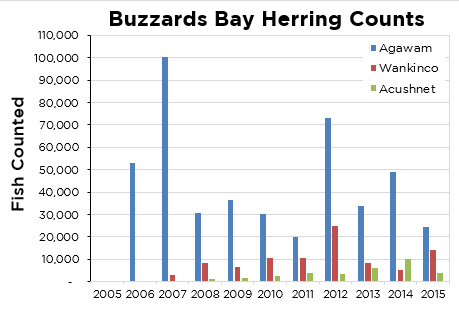Disappointing river herring counts in Buzzards Bay rivers in 2015
Populations of river herring – a small, silvery fish that forms an important link in the food web – were down across Buzzards Bay’s rivers this spring despite increases in other parts of southern New England.
Each spring, millions of river herring migrate from the Atlantic Ocean to coastal rivers and streams to spawn, or reproduce. The Coalition, along with the Massachusetts Division of Marine Fisheries and other local groups, monitors herring populations in several Buzzards Bay rivers to track how many fish return to the region every year.
This tracking is important because river herring populations have been in decline for many years. About a decade ago, the stock began to collapse up and down the East Coast. A number of factors led to their downturn, including pollution, dams and other river blockages, overfishing, and bycatch from commercial fisheries in the Atlantic Ocean. This year’s long, cold winter and late start to spring also likely put additional strain on smaller runs.
A loss of river herring is bad news for the Buzzards Bay ecosystem. Without enough herring swimming up the Bay’s rivers each spring, sportfish like striped bass and bluefish and water birds have less food to eat. River herring are one of the main food sources for the Bay’s endangered roseate tern populations on Penikese, Bird, and Ram islands.

River herring counts were down in the Agawam River in Wareham and the Acushnet River in Acushnet in 2015.
In the Acushnet River, nearly 3,700 river herring were counted in 2015. This is a significant drop from last year, but still the third-highest count since monitoring began in 2005. On the Agawam River in Wareham, the Coalition counted over 24,000 fish – about half as many as were recorded in 2014. The Mattapoisett River was down as well. The only local increase in river herring was observed on the Wankinco River (also in Wareham), where just over 14,000 fish swam upstream.
In contrast, the nearby Nemasket River in Middleborough saw an increase to nearly 750,000 river herring this spring.
The return of river herring each spring is triggered by temperature; when the water warms to just over 50 degrees, river herring begin swimming back to the streams where they were born. But because of the long, cold winter, water temperatures took longer to warm up. As a result, spawning runs started very late this year. Once this spring’s herring run did begin, it got off to a strong start. However, it soon tapered off.
There’s another piece of the river herring puzzle — this one located far away from Buzzards Bay, out at sea. Commercial fisheries for mackerel and Atlantic herring have expanded in recent years, and the vessels trawling for these valuable species can accidentally catch river herring in their nets. This is called bycatch, and it’s a big problem for local river herring populations.
Although river herring were down this year in the Buzzards Bay region, there’s still some good news for these fish. In recent years, more herring have been returning to the Bay’s rivers each spring. In 2006, for instance, just 202 river herring were counted in the Acushnet River. The Coalition will continue tracking river herring to monitor their health in the coming years.